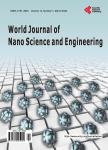The Effect of Carbon Rod—Specimens Distance on the Structural and Electrical Properties of Carbon Nanotube
The Effect of Carbon Rod—Specimens Distance on the Structural and Electrical Properties of Carbon Nanotube作者机构:Department of Physics College of Science Mosul University Mosul Iraq
出 版 物:《World Journal of Nano Science and Engineering》 (纳米科学与工程(英文))
年 卷 期:2014年第4卷第3期
页 面:105-110页
学科分类:1002[医学-临床医学] 100214[医学-肿瘤学] 10[医学]
主 题:Carbon Nanotubes Si-CNT Junction Plasma Sputtering of CNT
摘 要:The research studies the effect of the distance between the sample and the plasma sputtering source on the properties of the junction (silicon wafer-carbon nanotubes). The silicon wafer is fixed at (near, medium and far distances from the plasma source which is in the form of high purity graphite rod heated electrically). For the three cases, thickness of the sample is constant (20 nm). The samples were studied by scanning electron (SEM) and atomic force microscopes (AFM), X-ray and Raman spectra. For optimum distances the carbon layer is in the form of multi wall carbon nanotube (MWCNT). SEM images shows no formation of CNT on the Si wafer for near distance, which is consistent with the AFM images, X-ray and Raman spectrograms and no existence of characteristics (002) peaks whereas it appears for medium and longer distances, and by experience the optimum distance was found. This means that at closer distance high energy and high intensity plasma particles prevent the formation of CNT. This effect decreases with increasing distance of substrate from the graphite rod.



